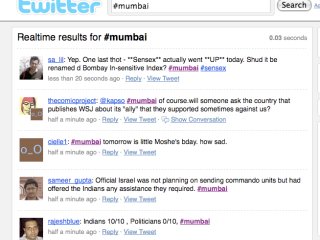After the Mumbai bombing, it’s clear that Twitter is
becoming a 24/7, round-the-clock, breaking news phenomena, and a compelling alternative to the
world’s most deep-pocketed, sophisticated and expansive news
organizations.
It’s a big leap forward from the seemingly simple but innovative news feeds started by Facebook nearly three years ago.
When Facebook released its news feed back in 2006, there was a backlash from its community and observers, saying that news feeds were invading their privacy. Back then, I applauded the move, and wrote: “Oh, pa-lease. Well,
welcome to the consequences of having 15 minutes of fame. You made your
public bed, now sleep in it. The complaints are akin to an actor who
becomes indignant because of the paparazzi… I think the personal information news feed is
an obvious evolutionary step to the Web 2.0 world we live in…
We live in an age where what we do, and who we are, is the news. What’s the difference in how people get it?”
Nearly three years later, we’re seeing the evolution of such news feeds, and the growing acceptance of transparency and appreciation of collective actions and thought.
Through Twitter – a service designed to be the megaphone of the world’s
ambient noise – a tapestry of insight and comprehension (with rounding
errors) is woven together to bring about understanding of events. In
essence, it’s providing what newsrooms have been mandated to do for
centuries – news.


It became pretty clear that Twitter was providing far more color than any news organization could during the presidential elections.
Today, it’s clearer that Twitter is the conduit of more than just color. (See: Eyewitness Twitter – on Mumbai bomb blast)
On Twitter, we’re seeing how collective actions – first-hand accounts, commentary, color, analysis, reporting – are bringing to our desktops the most information in the quickest period of time. As I wrote yesterday, the information flow is far more than any world-class news gathering organization, like CNN (my former employer) could ever provide.
Having started at CNN, and having worked as a journalist for the majority of my career, there is no doubt in my mind that when it comes to delivering quantity and even quality to some extent, the most trained, aggressive, experienced news team is at a disadvantage when up against thousands at their computers.
Just today, I went online to learn more about the Mumbai event. Here’s the latest from Twitter and its news reporters from around the world.
Here’s a list of the injured: The injured and the dead
Here’s thoughtful commentary from a blogger in India: Mumbai terror attack – some thoughts
Here’s a “new” news source: New America Media; expanding the news lens through ethnic media
Here’s a report about rescue teams: Israeli rescue team heads to Mumbai
Here’s a report a report about cops dying in India: Three top cops die on duty
Here’s a photo of a fugitive: Tarek El-Zoghpy
Admittedly, as I said in my post yesterday, there is significant rounding error when it comes to the information provided. This is to be expected. As a journalist, I also had to deal with a huge amount of erroneous reports. It was my job to vet the information.
Today, we’re all journalists. We’re all doing the editing; we’re doing the reporting. We’re part of the world’s biggest newsroom, providing the news feed, one person at a time.
















